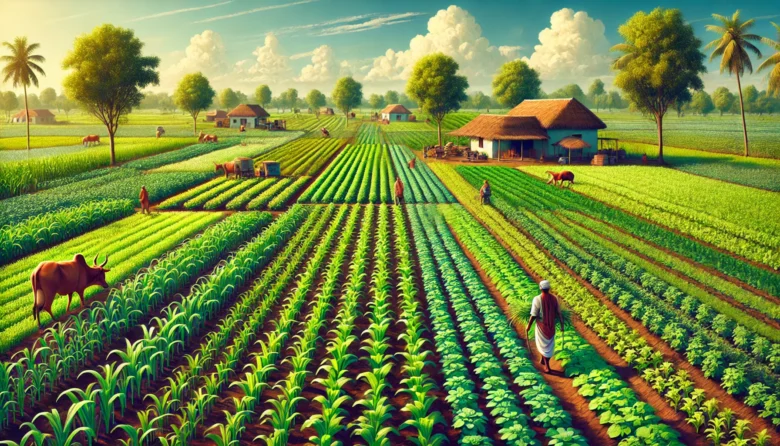India is a land rich in agriculture, and farming is the backbone of our economy. However, with increasing soil degradation and the pressing issue of climate change, farmers are constantly seeking sustainable solutions. One promising solution is biochar, a revolutionary method that boosts soil fertility and helps in carbon sequestration. Let’s dive into how biochar can transform agriculture in India.
What is Biochar?
Biochar is a form of charcoal produced by heating organic material (like crop residues) without oxygen, a process known as pyrolysis. Unlike regular charcoal, biochar is specifically used to improve soil health and sequester carbon, making it a valuable tool for farmers and environmentalists.
How Biochar Enhances Soil Fertility
Improves Soil Structure: Biochar helps create a porous soil structure, which improves aeration and water retention. This is particularly beneficial in regions with heavy clay or sandy soils, which are common in many parts of India.
Increases Nutrient Retention: One critical benefit of biochar is its ability to retain nutrients. It acts like a sponge, holding nutrients and slowly releasing them to plants. This reduces the need for chemical fertilizers, leading to cost savings for farmers.
Enhances Microbial Activity: Biochar provides a habitat for beneficial soil microbes. These microbes play a crucial role in breaking down organic matter and releasing nutrients, thus boosting soil fertility.

Biochar and Carbon Sequestration
Biochar enhances soil health and significantly contributes to carbon sequestration. When organic material is transformed into biochar, carbon is stabilized, preventing its release into the atmosphere as carbon dioxide (CO2). This process is crucial in mitigating climate change by locking carbon into the soil for centuries, a key benefit of biochar.
Application of Biochar in Indian Agriculture
Smallholder Farmers: Smallholder farmers comprise most of India’s farming community and are integral to the biochar process. Using locally available crop residues to produce biochar can improve soil fertility and crop yields sustainably, empowering them in the fight against soil degradation and climate change.
Large-Scale Farms: Biochar can be integrated into existing soil management practices for larger farms. It can be combined with compost or manure to enhance its effectiveness.
Urban Gardening: Biochar is not limited to rural areas. Urban gardeners can use it to improve the quality of their soil and increase plant productivity.
Making Biochar: A Step-by-Step Guide
Collect Organic Material: Gather agricultural waste such as rice husks, coconut shells, or wood chips.
Set Up a Kiln: You can use a simple, homemade kiln or a more sophisticated biochar production unit. The key is to ensure the process occurs in the absence of oxygen.
Pyrolysis Process: The organic material is heated in the kiln to 300-600°C, which will take several hours.
Cool and Crush: Once the pyrolysis is complete, let the biochar cool. Crush it into smaller pieces before applying it to the soil.
Success Stories from India
Several farmers in India have already started using biochar with remarkable results. For example, a group of farmers in Karnataka reported a 30% increase in crop yields after using biochar. Similarly, in Punjab, biochar has helped improve soil health and reduce the dependence on chemical fertilizers.
Challenges and Considerations
While biochar offers numerous benefits, there are some challenges to consider:
Initial Investment: Setting up a biochar production unit may require an initial investment. However, this cost can be offset by the long-term benefits, providing farmers with reassurance about the value of their investment.
Knowledge and Training: Farmers need proper training to produce and apply biochar effectively. Extension services and agricultural universities can play a vital role in this regard.
Government and NGO Initiatives
The Indian government and various NGOs are recognizing the potential of biochar. Programs promoting sustainable agriculture practices are beginning to include biochar in their recommendations. For instance, the Indian Council of Agricultural Research (ICAR) is conducting research and trials to understand the best practices for biochar application in different regions.
The Future of Biochar in India
As awareness about biochar grows, it is set to become a cornerstone of sustainable agriculture in India. Its unique ability to enhance soil fertility and sequester carbon perfectly aligns with the country’s goals of increasing agricultural productivity and combating climate change, making it a promising solution for the future of Indian agriculture.
By embracing biochar, Indian farmers can pave the way for a more sustainable and prosperous future. It’s time to integrate this ancient practice with modern science and reap the benefits for future generations. The potential of biochar is immense, and we must recognize and harness it to improve our agriculture and planet.
Author’s Note
Thank you for taking the time to read about biochar. As an advocate for sustainable agriculture, I know that small changes can make a big difference. Let’s work together to promote practices that benefit our farmers and the planet.
G.C., Ecosociosphere contributor.
References and Further Reading
- International Biochar Initiative
- ICAR Biochar Research
- Biochar can be tailor-made for range of environmental benefits, research shows | Folio. https://www.ualberta.ca/folio/2019/01/biochar-can-be-tailor-made-for-range-of-environmental-benefits-research-shows.html
- Soil pH in Organic Farm – TouchTECHNO. https://touchtechno.com/soil-ph-in-organic-farm/
- Assessing The Economic And Environmental Impact Of Green Buildings – Carbon.Credit Research of Carbon Credit Markets. https://blog.carbon.credit/2023/01/19/assessing-the-economic-and-environmental-impact-of-green-buildings/
- Subsistence Farming In India | Taro Pumps. https://www.taropumps.com/blog/subsistence-farming-in-india
- Ghimire, M., Khanal, A., Bhatt, D., Dahal, D. R., & Giri, S. (2024). Agroforestry systems in Nepal: Enhancing food security and rural livelihoods – a comprehensive review. Food and Energy Security. https://doi.org/10.1002/fes3.524




